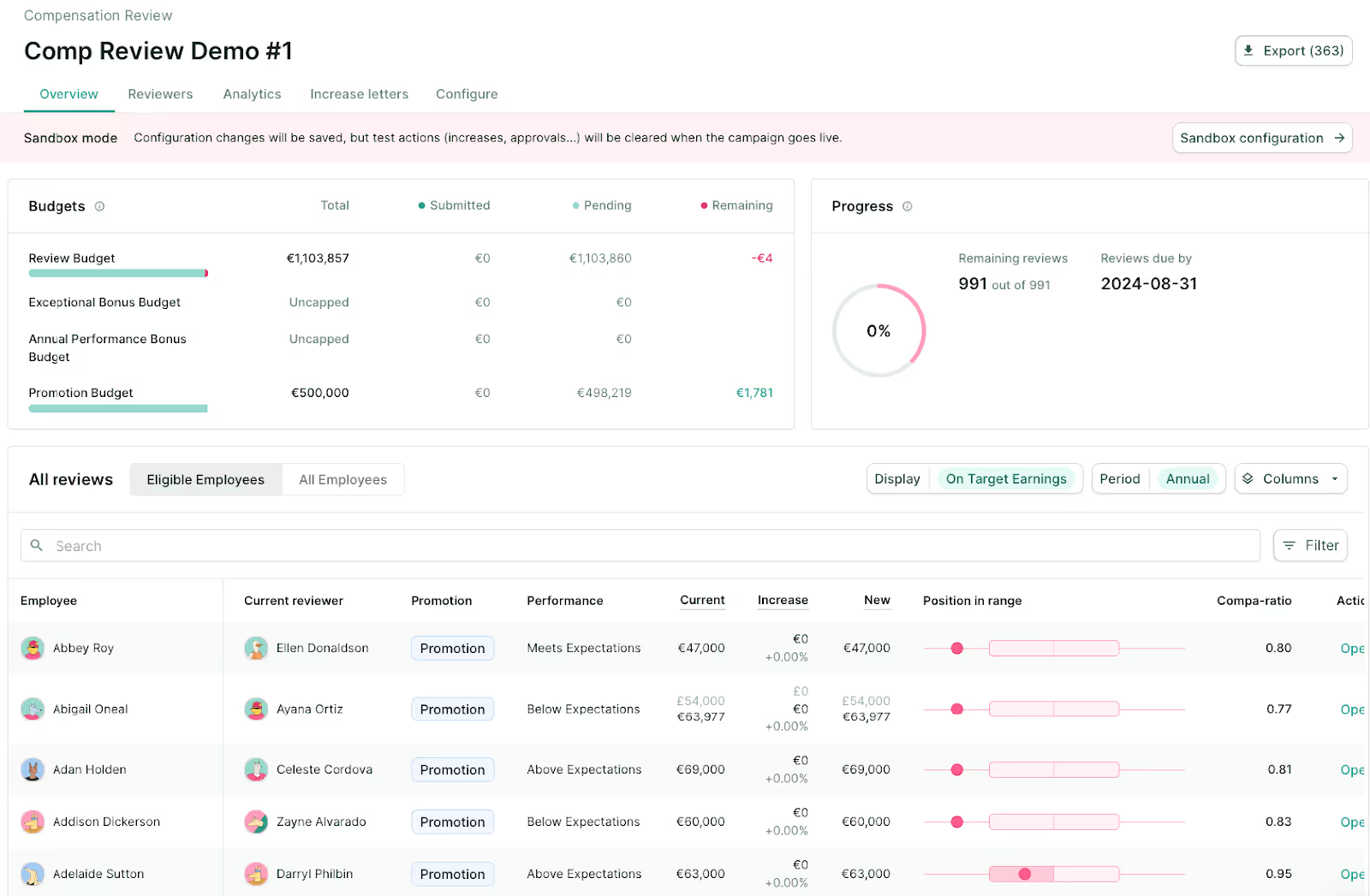Key points:
- Total rewards go beyond salary: Effective strategies balance base pay with bonuses, benefits, development opportunities, and flexible working arrangements.
- Our PACE framework drives results: Plan with benchmarks, Align with values, Communicate transparently, and Evaluate continuously for a structured approach to rewards.
- Different employees value different rewards: Gen Z prioritises learning and flexibility, while Gen X values stability. In every case, personalisation improves retention.
- Data-driven decisions prevent costly mistakes: Without reliable benchmarks, you risk overpaying some roles while losing talent in others to competitors.
- Transparency builds trust: Clear communication about reward criteria and decisions, using simple language instead of HR jargon, strengthens employee engagement.
A compensation and reward strategy is a structured approach to recognising and compensating employees for their contributions to organisational success. And if you’re struggling to keep your staff motivated and aligned with the company goals, a great reward strategy is precisely what you need.
Organisations with recognition programs experience 31% lower voluntary turnover and are 12 times more likely to achieve strong business outcomes, according to Deloitte research. Those numbers represent real people choosing to stay rather than leave.
So, how can you join the elite club of companies whose employees actually smile on Mondays? Well, you need a reward strategy that encompasses everything from base salaries and bonuses to professional development opportunities and flexible working arrangements. You also have to recognise employees for specific achievements: hitting sales targets, leading successful projects, improving customer satisfaction scores, or mentoring new team members.
If you’re successful, you’ll gain the power to attract qualified candidates, keep productive employees engaged, and align individual performance with company goals. And on top of that, you might even get some high-quality referrals.
The good news? Refreshing your approach doesn’t require starting from scratch.
Now, let’s explore how to build a reward strategy that actually works for retention.
The total rewards approach: beyond salary
Base salary alone rarely tells the full story. Your best employees value recognition, growth opportunities, and a work-life balance just as much as their monthly paycheck. Most of all, they want to know their contributions matter and that they’re building a career, not just collecting a salary.
Here’s what a total rewards structure might include:
Financial rewards:
- Performance bonuses tied to individual or team achievements.
- Profit-sharing schemes that connect employees to company success.
- Commission structures for sales and revenue-generating roles.
- Spot bonuses for exceptional contributions.
Benefits and wellbeing extras:
- Flexible working hours that respect personal commitments.
- Additional holiday allowance beyond statutory minimums.
- Private health insurance and wellness programmes.
- Mental health support and employee assistance programmes.
- Childcare vouchers or nursery partnerships.
Development opportunities:
- Professional qualification sponsorship.
- Conference attendance and industry networking.
- Internal mentorship programmes.
- Cross-departmental project opportunities.
- Leadership development pathways.
What you need to remember is that the most effective reward strategies recognise that different employees value different things. A new parent might prioritise flexible hours and childcare support. An ambitious graduate might value rapid progression and learning opportunities. Someone close to retirement might focus on pension contributions and health benefits.
That’s to say, you can’t create high-quality reward systems if you have no idea what actually motivates your workforce. Survey data, exit interviews, and regular one-to-ones reveal which rewards resonate most with your teams. When you align rewards with what employees genuinely value, retention naturally improves.
PACE yourself: 4 steps to an effective total reward strategy
Building an effective reward strategy follows four clear steps: Plan, Align, Communicate, and Evaluate. Each step builds on the previous one to create an approach that actually improves retention.
Plan
Planning starts with understanding where you are now.
- Conduct a survey of employees to determine which rewards they value most and what motivates them daily.
- Benchmark against market rates. This happens when you compare salaries for similar roles in your industry and location, and then match those rates accordingly. Remember that doing this is just the starting point – your culture influences reward structure beyond base pay.
- Analyse compensation data across demographics, departments, and seniority levels. This will help you address pay gaps before they become retention issues or compliance problems under the EU Pay Transparency Directive.
- Set specific performance objectives for the variable compensation plan:
- Sales: Achieve X amount of money in new revenue.
- Projects: Deliver initiatives on time and within budget.
- Service: Maintain 95% satisfaction ratings.
- Innovation: Launch features that increase engagement by 15%.
- Structure your recognition process:
- Who recognises: Managers, peers, leadership, and customers.
- How often: Monthly team awards, quarterly individual recognition.
- Reward criteria: Clear links to company values and goals.
- Annual budget: Typically 1-2% of payroll.
This groundwork means your rewards actually match what the market pays AND what your company needs - novel concept, right?
{{cta}}
Align
Alignment ensures rewards reinforce what matters most to your organisation. A tech startup might reward innovation and risk-taking, while a financial services firm might emphasise accuracy and compliance.
Besides the company values, you should also consider different preferences across your workforce:
- Gen Z values learning opportunities and flexible working.
- Millennials seek career progression and purpose-driven work.
- Gen X appreciates work-life balance and stability.
- Different regions expect different benefit packages.
- Industry norms shape baseline expectations.
Besides the age and location of your employees, you should think about their job position:
- Engineers might value conference attendance and certification sponsorship.
- Sales teams might prefer commission structures and performance bonuses.
- Customer service staff might appreciate schedule flexibility and mental health benefits (we all know they need them).
"A big mistake we see is companies copying competitor reward strategies without understanding their own workforce," shares Virgile Raingeard, CEO of Figures and former HR leader. "Your developers might value conference budgets while your sales team couldn't care less – but you'll never know without asking."
👀 The point is, personalise where possible and LISTEN to your employees. If you don’t, you risk falling victim to people “quiet quitting” or perfecting the art of looking busy while mentally redecorating their future office at your competitor's place.
However, when rewards reflect company values, employees understand the connection between their contributions and recognition.
Communicate
Transparency builds trust in your reward system. Explain how decisions are made without drowning people in HR jargon.
Clear communication includes:
- Simple explanations of reward criteria.
- Context linking individual rewards to company performance.
- Regular updates on reward programme changes.
- Personalised statements showing each employee's total rewards package.
For an even bigger impact, share the success stories. When someone receives recognition, explain why. This reinforces desired behaviours and shows others what excellence looks like in practice.
Evaluate
Regular evaluation keeps your reward strategy relevant.
- Track retention rates, engagement scores, and performance indicators.
- Calculate ROI on reward investments by comparing programme costs to productivity gains and reduced turnover expenses.
- Gather feedback through pulse surveys, focus groups, and exit interviews.
- Test different reward approaches with pilot groups before rolling out company-wide.
- Design reviews that ensure your strategy evolves in response to changing workforce needs and market conditions.
Implement data-driven rewards strategies with Figures
Creating an effective reward strategy requires accurate, real-time compensation data. Without reliable benchmarks, you're basically playing 'Pin the Salary on the Employee' while blindfolded, potentially overpaying for some roles while losing talent in others due to below-market compensation.
Figures is a platform that transforms how HR teams and managers collaborate on reward decisions. The Compensation Review feature replaces error-prone spreadsheets with an intuitive workspace where teams can make confident, data-backed salary adjustments.
Key features that support strategic rewards:
- Real-time budget tracking: Monitor spending as you make decisions, preventing budget overruns.
- Collaborative workflows: Managers access clear dashboards showing team compensation data and can submit justified recommendations.
- Market benchmarking: Access to 5 million data points (yes, you heard that right) ensures you'll finally know if that 'competitive' salary you're offering is actually competitive, not just what you hope is competitive.
- Flexible review cycles: Handle annual reviews alongside off-cycle adjustments for promotions or market corrections.
- Built-in analytics: Track the impact of reward decisions on pay equity and team retention.
The platform turns what usually takes weeks into a smooth, transparent process.
Before Figures: you're basically recreating the Charlie Day meme in your office – disheveled, surrounded by spreadsheets linked with red string, ranting about market rates while your team backs away slowly.
After Figures: you have the necessary data presented in an intuitive interface, giving decision-makers all the information they need to make informed choices. Compensation reviews are performed in a way that gently guides everyone involved, while HR maintains full visibility and control over budgets and approvals.
"Both for the HR team and managers, using such a tool represents a real time saver," shares Anne Le Bruchec, Chief People Officer at Swan. "The time saved is reinvested in deeper discussions about each salary increase decision."
Take a look for yourself!

{{cta}}
Transform your retention rates with a modern reward strategy
A well-designed compensation and reward strategy is your biggest ally in successful talent retention. It solves the challenge of keeping your best people engaged while attracting new talent in an increasingly more competitive market. It turns your office from a revolving door of 'thanks for the experience, bye!' into a place where people actually want to stay.
To be successful, you need to remember the PACE framework:
- Plan with accurate benchmarks.
- Align rewards with company values.
- Communicate transparently.
- Evaluate continuously.
This structured approach transforms disengaged, bored teams into motivated and happy employees who understand how their jobs connect to recognition and rewards.
The upcoming EU Pay Transparency Directive makes having reliable compensation data even more critical. Companies need systems that justify pay decisions with solid evidence that comes on time (!!!) while still ensuring fairness across all employee groups.
Figures' Compensation Review solution provides the real-time data, collaborative tools, and analytics you need to build a reward strategy that works. From market benchmarking to budget tracking, it replaces guesswork with confidence.
Ready to refresh your reward strategy? Book a free demo and discover how data-driven compensation decisions can transform your retention rates.
Summarize this article with AI
No time to read it all? Get a clear, structured, and actionable summary in one click.


.png)
.png)
.jpg)

